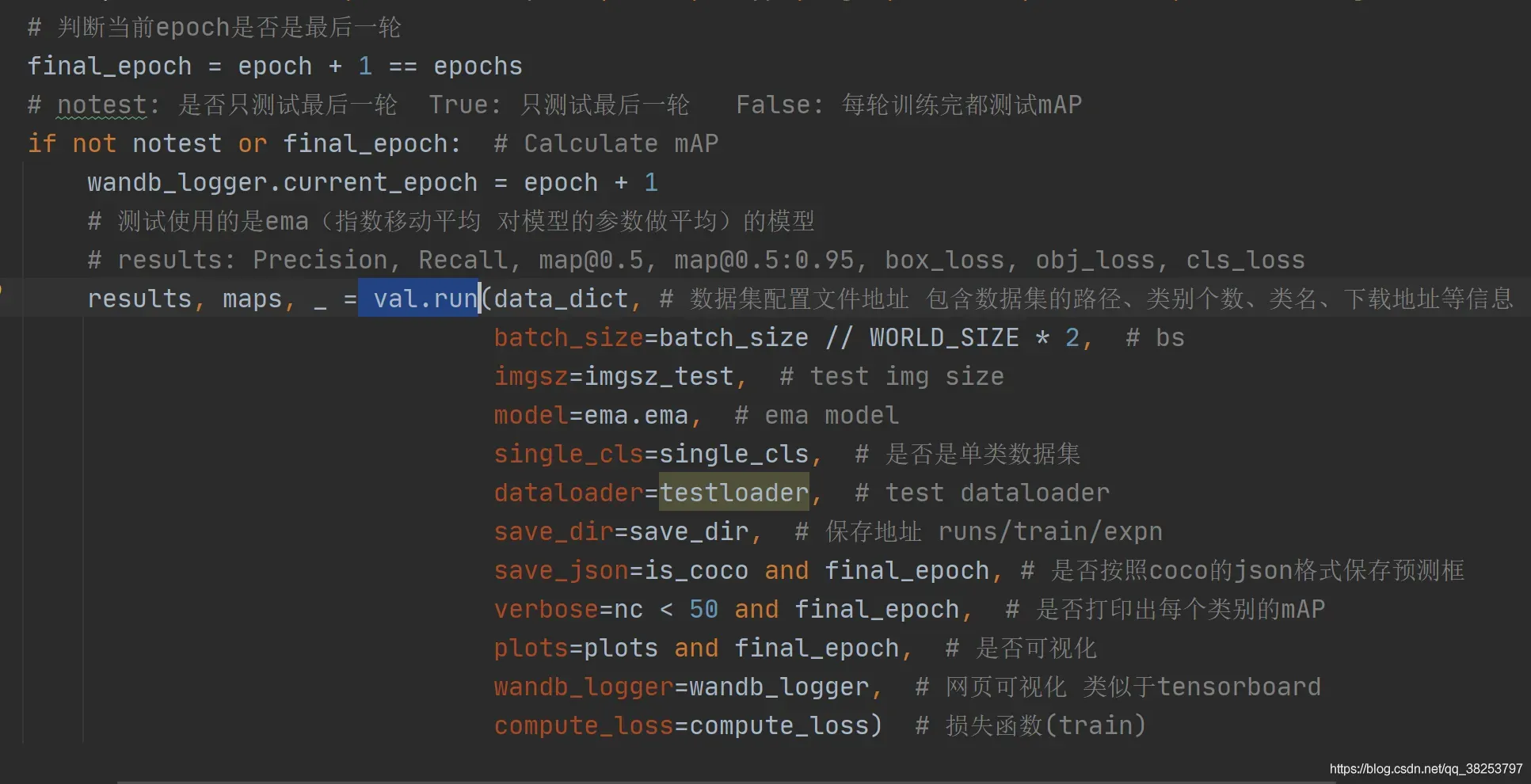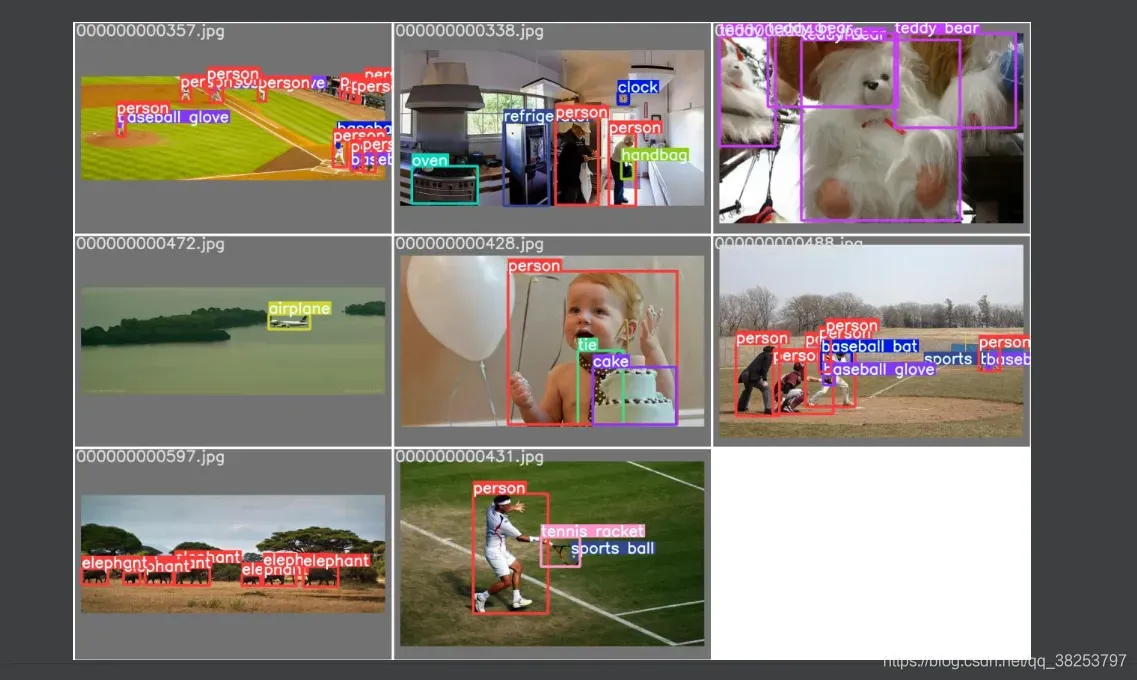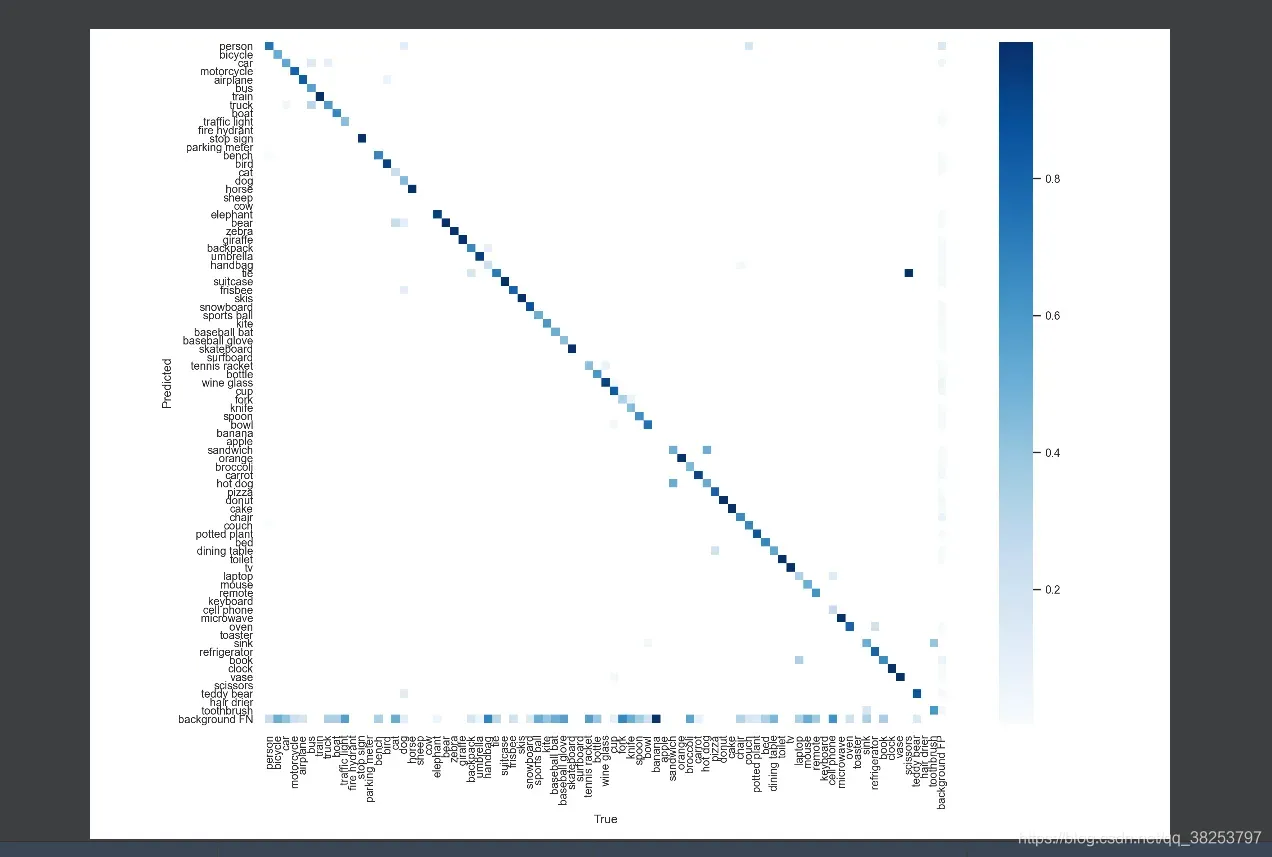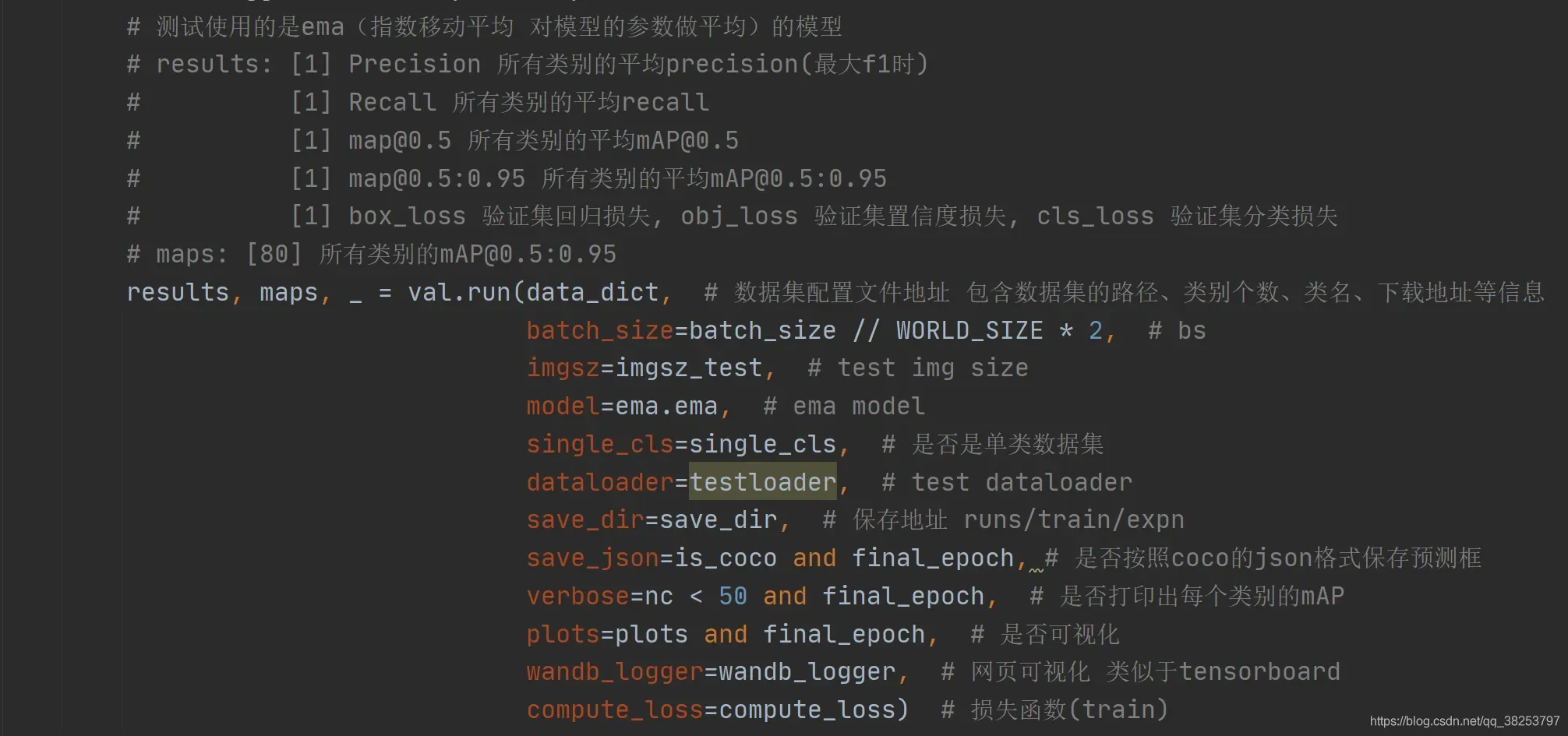内容
- 前言
- 0、导入需要的包和基本配置
- 1、设置opt参数
- 2、执行main函数
- 3、执行run函数
- 3.1、载入参数
- 3.2、初始化配置1
- 3.3、调整模型
- 3.4、初始化配置2
- 3.5、加载val数据集
- 3.6、初始化配置3
- 3.7、开始验证
- 3.7.1、预处理图片和target
- 3.7.2、model 前向推理
- 3.7.3、计算验证集损失
- 3.7.4、Run NMS
- 3.7.5、统计每张图片的真实框、预测框信息
- 3.7.6、保存预测信息到image_name.txt文件
- 3.7.7、保存预测信息到wandb_logger
- 3.7.8、将预测信息保存到coco格式的json字典
- 3.7.9、计算混淆矩阵、计算correct、生成stats
- 3.7.10、画出前三个batch图片的gt和pred框
- 3.7.11、计算mAP
- 3.7.12、print打印各项指标
- 3.7.13、画出混淆矩阵并存入wandb_logger中
- 3.7.14、Save JSON
- 3.7.15、 Return results
- 总结
前言
源码:YOLOv5源码.
导航:【YOLOV5-5.x 源码讲解】整体项目文件导航.
注释版全部项目文件已上传至GitHub:yolov5-5.x-annotations.
这个文件主要是在每一轮训练结束后,验证当前模型的mAP、混淆矩阵等指标。这个文件本来是叫test.py的,但我觉得叫val.py可能更加恰当些,所以改了。
实际上这个脚本最常用的应该是通过train.py调用 run 函数,而不是通过执行 val.py 的。所以在了解这个脚本的时候,其实最重要的就是 run 函数。
0、导入需要的包和基本配置
import argparse # 解析命令行参数模块
import json # 实现字典列表和JSON字符串之间的相互解析
import os # 与操作系统进行交互的模块 包含文件路径操作和解析
import sys # sys系统模块 包含了与Python解释器和它的环境有关的函数
from pathlib import Path # Path将str转换为Path对象 使字符串路径易于操作的模块
from threading import Thread # 线程操作模块
import numpy as np
import torch
import yaml
from tqdm import tqdm
FILE = Path(__file__).absolute() # FILE = WindowsPath 'F:\yolo_v5\yolov5-U\val.py'
# 将'F:/yolo_v5/yolov5-U'加入系统的环境变量 该脚本结束后失效
sys.path.append(FILE.parents[0].as_posix()) # add yolov5/ to path
from models.experimental import attempt_load
from utils.datasets import create_dataloader
from utils.general import coco80_to_coco91_class, check_dataset, check_file, check_img_size, check_requirements, \
box_iou, non_max_suppression, scale_coords, xyxy2xywh, xywh2xyxy, set_logging, increment_path, colorstr
from utils.metrics import ap_per_class, ConfusionMatrix
from utils.plots import plot_images, output_to_target, plot_study_txt
from utils.torch_utils import select_device, time_synchronized
1、设置opt参数
def parse_opt():
"""
opt参数详解
data: 数据集配置文件地址 包含数据集的路径、类别个数、类名、下载地址等信息
weights: 模型的权重文件地址 weights/yolov5s.pt
batch_size: 前向传播的批次大小 默认32
imgsz: 输入网络的图片分辨率 默认640
conf-thres: object置信度阈值 默认0.25
iou-thres: 进行NMS时IOU的阈值 默认0.6
task: 设置测试的类型 有train, val, test, speed or study几种 默认val
device: 测试的设备
single-cls: 数据集是否只用一个类别 默认False
augment: 测试是否使用TTA Test Time Augment 默认False
verbose: 是否打印出每个类别的mAP 默认False
下面三个参数是auto-labelling(有点像RNN中的teaching forcing)相关参数详见:https://github.com/ultralytics/yolov5/issues/1563 下面解释是作者原话
save-txt: traditional auto-labelling
save-hybrid: save hybrid autolabels, combining existing labels with new predictions before NMS (existing predictions given confidence=1.0 before NMS.
save-conf: add confidences to any of the above commands
save-json: 是否按照coco的json格式保存预测框,并且使用cocoapi做评估(需要同样coco的json格式的标签) 默认False
project: 测试保存的源文件 默认runs/test
name: 测试保存的文件地址 默认exp 保存在runs/test/exp下
exist-ok: 是否存在当前文件 默认False 一般是 no exist-ok 连用 所以一般都要重新创建文件夹
half: 是否使用半精度推理 默认False
"""
parser = argparse.ArgumentParser(prog='val.py')
parser.add_argument('--data', type=str, default='data/coco128.yaml', help='dataset.yaml path')
parser.add_argument('--weights', nargs='+', type=str, default='weights/yolov5s.pt', help='model.pt path(s)')
parser.add_argument('--batch-size', type=int, default=4, help='batch size')
parser.add_argument('--imgsz', '--img', '--img-size', type=int, default=640, help='inference size (pixels)')
parser.add_argument('--conf-thres', type=float, default=0.001, help='confidence threshold')
parser.add_argument('--iou-thres', type=float, default=0.6, help='NMS IoU threshold')
parser.add_argument('--task', default='val', help='train, val, test, speed or study')
parser.add_argument('--device', default='', help='cuda device, i.e. 0 or 0,1,2,3 or cpu')
parser.add_argument('--single-cls', action='store_true', help='treat as single-class dataset')
parser.add_argument('--augment', action='store_true', help='augmented inference')
parser.add_argument('--verbose', action='store_true', help='report mAP by class')
parser.add_argument('--save-txt', default=True, action='store_true', help='save results to *.txt')
parser.add_argument('--save-hybrid', action='store_true', help='save label+prediction hybrid results to *.txt')
parser.add_argument('--save-conf', default=True, action='store_true', help='save confidences in --save-txt labels')
parser.add_argument('--save-json', action='store_true', help='save a cocoapi-compatible JSON results file')
parser.add_argument('--project', default='runs/test', help='save to project/name')
parser.add_argument('--name', default='exp', help='save to project/name')
parser.add_argument('--exist-ok', action='store_true', help='existing project/name ok, do not increment')
parser.add_argument('--half', action='store_true', help='use FP16 half-precision inference')
opt = parser.parse_args() # 解析上述参数
opt.save_json |= opt.data.endswith('coco.yaml') # |或 左右两个变量有一个为True 左边变量就为True
opt.save_txt |= opt.save_hybrid
opt.data = check_file(opt.data) # check file
return opt
2、执行main函数
def main(opt):
# 初始化日志 设置logging的等级level、输出格式和内容format等基本信息
set_logging()
# 打印信息 test(高亮): opt各个参数值
print(colorstr('test: ') + ', '.join(f'{k}={v}' for k, v in vars(opt).items()))
# 检测requirements文件中需要的包是否安装好了
check_requirements(exclude=('tensorboard', 'thop'))
# 如果task in ['train', 'val', 'test']就正常测试 训练集/验证集/测试集
if opt.task in ('train', 'val', 'test'): # run normally
run(**vars(opt))
# 如果opt.task == 'speed' 就测试yolov5系列和yolov3-spp各个模型的速度评估
elif opt.task == 'speed': # speed benchmarks
for w in opt.weights if isinstance(opt.weights, list) else [opt.weights]:
run(opt.data, weights=w, batch_size=opt.batch_size, imgsz=opt.imgsz, conf_thres=.25, iou_thres=.45,
save_json=False, plots=False)
# 如果opt.task = ['study']就评估yolov5系列和yolov3-spp各个模型在各个尺度下的指标并可视化
elif opt.task == 'study': # run over a range of settings and save/plot
# python val.py --task study --data coco.yaml --iou 0.7 --weights yolov5s.pt yolov5m.pt yolov5l.pt yolov5x.pt
x = list(range(256, 1536 + 128, 128)) # x axis (image sizes)
for w in opt.weights if isinstance(opt.weights, list) else [opt.weights]:
f = f'study_{Path(opt.data).stem}_{Path(w).stem}.txt' # filename to save to
y = [] # y axis
for i in x: # img-size
print(f'\nRunning {f} point {i}...')
r, _, t = run(opt.data, weights=w, batch_size=opt.batch_size, imgsz=i, conf_thres=opt.conf_thres,
iou_thres=opt.iou_thres, save_json=opt.save_json, plots=False)
y.append(r + t) # results and times
np.savetxt(f, y, fmt='%10.4g') # save
os.system('zip -r study.zip study_*.txt')
# 可视化各个指标
plot_study_txt(x=x) # plot
可以看到这个模块根据opt.task可以分为三个分支,我们主要的分支还是在 opt.task in (‘train’, ‘val’, ‘test’)。而其他的两个分支,大家大概看看在干什么就可以了,没什么用。一般我们都是直接进入第一个分支,执行run函数。
3、执行run函数
run 函数其实用train.py执行的,并不是执行val.py。
train.py调用(每个训练epoch后验证当前模型):
3.1、载入参数
@torch.no_grad() # 不参与反向传播
def run(data, weights=None, batch_size=32, imgsz=640, conf_thres=0.001, iou_thres=0.6,
task='val', device='', single_cls=False, augment=False, verbose=False, save_txt=False,
save_hybrid=False, save_conf=False, save_json=False, project='runs/test', name='exp',
exist_ok=False, half=True, model=None, dataloader=None, save_dir=Path(''), plots=True,
wandb_logger=None, compute_loss=None,
):
"""
:params data: 数据集配置文件地址 包含数据集的路径、类别个数、类名、下载地址等信息 train.py时传入data_dict
:params weights: 模型的权重文件地址 运行train.py=None 运行test.py=默认weights/yolov5s.pt
:params batch_size: 前向传播的批次大小 运行test.py传入默认32 运行train.py则传入batch_size // WORLD_SIZE * 2
:params imgsz: 输入网络的图片分辨率 运行test.py传入默认640 运行train.py则传入imgsz_test
:params conf_thres: object置信度阈值 默认0.25
:params iou_thres: 进行NMS时IOU的阈值 默认0.6
:params task: 设置测试的类型 有train, val, test, speed or study几种 默认val
:params device: 测试的设备
:params single_cls: 数据集是否只用一个类别 运行test.py传入默认False 运行train.py则传入single_cls
:params augment: 测试是否使用TTA Test Time Augment 默认False
:params verbose: 是否打印出每个类别的mAP 运行test.py传入默认Fasle 运行train.py则传入nc < 50 and final_epoch
:params save_txt: 是否以txt文件的形式保存模型预测框的坐标 默认True
:params save_hybrid: 是否save label+prediction hybrid results to *.txt 默认False
:params save_conf: 是否保存预测每个目标的置信度到预测tx文件中 默认True
:params save_json: 是否按照coco的json格式保存预测框,并且使用cocoapi做评估(需要同样coco的json格式的标签)
运行test.py传入默认Fasle 运行train.py则传入is_coco and final_epoch(一般也是False)
:params project: 测试保存的源文件 默认runs/test
:params name: 测试保存的文件地址 默认exp 保存在runs/test/exp下
:params exist_ok: 是否存在当前文件 默认False 一般是 no exist-ok 连用 所以一般都要重新创建文件夹
:params half: 是否使用半精度推理 FP16 half-precision inference 默认False
:params model: 模型 如果执行test.py就为None 如果执行train.py就会传入ema.ema(ema模型)
:params dataloader: 数据加载器 如果执行test.py就为None 如果执行train.py就会传入testloader
:params save_dir: 文件保存路径 如果执行test.py就为‘’ 如果执行train.py就会传入save_dir(runs/train/expn)
:params plots: 是否可视化 运行test.py传入默认True 运行train.py则传入plots and final_epoch
:params wandb_logger: 网页可视化 类似于tensorboard 运行test.py传入默认None 运行train.py则传入wandb_logger(train)
:params compute_loss: 损失函数 运行test.py传入默认None 运行train.py则传入compute_loss(train)
:return (Precision, Recall, map@0.5, map@0.5:0.95, box_loss, obj_loss, cls_loss)
"""
3.2、初始化配置1
训练时(train.py)调用:初始化模型参数、训练设备
验证时(val.py)调用:初始化设备、save_dir文件路径、make dir、加载模型、check imgsz、 加载+check data配置信息
# ============================================== 1、初始化配置1 ==================================================
# 初始化模型并选择相应的计算设备
# 判断是否是训练时调用run函数(执行train.py脚本), 如果是就使用训练时的设备 一般都是train
training = model is not None
if training: # called by train.py
device = next(model.parameters()).device # get model device
# 如果不是trin.py调用run函数(执行val.py脚本)就调用select_device选择可用的设备
# 并生成save_dir + make dir + 加载模型model + check imgsz + 加载data配置信息
else:
device = select_device(device, batch_size=batch_size)
# 生成save_dir文件路径 run\test\expn
save_dir = increment_path(Path(project) / name, exist_ok=exist_ok) # increment run
# make dir run\test\expn\labels
(save_dir / 'labels' if save_txt else save_dir).mkdir(parents=True, exist_ok=True)
# 加载模型 load FP32 model 只在运行test.py才需要自己加载model
model = attempt_load(weights, map_location=device)
# gs: 模型最大的下采样stride 一般[8, 16, 32] 所有gs一般是32
gs = max(int(model.stride.max()), 32) # grid size (max stride)
# 检测输入图片的分辨率imgsz是否能被gs整除 只在运行test.py才需要自己生成check imgsz
# imgsz_test
imgsz = check_img_size(imgsz, s=gs) # check image size
# Multi-GPU disabled, incompatible with .half() https://github.com/ultralytics/yolov5/issues/99
# if device.type != 'cpu' and torch.cuda.device_count() > 1:
# model = nn.DataParallel(model)
# Data 加载数据配置信息 只有运行test.py才需要加载数据配置信息, 因为它需要根据data生成新的dataloader
# 而运行train.py时是直接传入testloader的, 所以不需要加载数据配置信息
with open(data, encoding='utf-8') as f:
data = yaml.safe_load(f)
check_dataset(data) # check
3.3、调整模型
半精度验证half model + 模型剪枝prune + 模型融合conv+bn
# ============================================== 2、调整模型设置 ==================================================
# Half model 只能在单GPU设备上才能使用
# 一旦使用half, 不但模型需要设为half, 输入模型的图片也需要设为half
half &= device.type != 'cpu' # half precision only supported on CUDA
if half:
model.half()
# from utils.torch_utils import prune
# prune(model, 0.3) # 模型剪枝
# model = model.fuse() # 模型融合 融合conv+bn
model.eval() # 启动模型验证模式
3.4、初始化配置2
是否是coco数据集is_coco + 类别个数nc + 计算mAP相关参数 + 初始化日志 Logging
# ============================================== 3、初始化配置2 ==================================================
# 测试数据是否是coco数据集
is_coco = type(data['val']) is str and data['val'].endswith('coco/val2017.txt') # COCO dataset bool
nc = 1 if single_cls else int(data['nc']) # number of classes
# 计算mAP相关参数
# 设置iou阈值 从0.5-0.95取10个(0.05间隔) iou vector for mAP@0.5:0.95
# # iouv: [0.50000, 0.55000, 0.60000, 0.65000, 0.70000, 0.75000, 0.80000, 0.85000, 0.90000, 0.95000]
iouv = torch.linspace(0.5, 0.95, 10).to(device)
# mAP@0.5:0.95 iou个数=10个
niou = iouv.numel()
# 初始化日志 Logging
log_imgs = 0
if wandb_logger and wandb_logger.wandb:
log_imgs = min(wandb_logger.log_imgs, 100)
3.5、加载val数据集
训练时(train.py)调用:加载val数据集
验证时(val.py)调用:不需要加载val数据集 直接从train.py 中传入testloader
# ============================================== 4、加载val数据集 ==================================================
# 如果不是训练(执行val.py脚本调用run函数)就调用create_dataloader生成dataloader
# 如果是训练(执行train.py调用run函数)就不需要生成dataloader 可以直接从参数中传过来testloader
if not training:
if device.type != 'cpu':
# 这里创建一个全零数组测试下前向传播是否能够正常运行
model(torch.zeros(1, 3, imgsz, imgsz).to(device).type_as(next(model.parameters()))) # run once
task = task if task in ('train', 'val', 'test') else 'val' # path to train/val/test images
# 创建dataloader 这里的rect默认为True 矩形推理用于测试集 在不影响mAP的情况下可以大大提升推理速度
dataloader = create_dataloader(data[task], imgsz, batch_size, gs, single_cls, pad=0.5, rect=True,
prefix=colorstr(f'{task}: '))[0]
3.6、初始化配置3
初始化混淆矩阵 + 数据集类名 + 获取coco数据集的类别索引 + 设置tqdm进度条 + 初始化p, r, f1, mp, mr, map50, map指标和时间t0, t1, t2 + 初始化测试集的损失 + 初始化json文件中的字典 统计信息 ap等
# ============================================== 5、初始化配置3 ==================================================
# 初始化一些测试需要的参数
seen = 0 # 初始化测试的图片的数量
# 初始化混淆矩阵
confusion_matrix = ConfusionMatrix(nc=nc)
# 获取数据集所有类别的类名
names = {k: v for k, v in enumerate(model.names if hasattr(model, 'names') else model.module.names)}
# 获取coco数据集的类别索引
# coco数据集是80个类 索引范围本应该是0~79,但是这里返回的确是0~90 coco官方就是这样规定的
# coco80_to_coco91_class就是为了与上述索引对应起来,返回一个范围在0~80的索引数组
coco91class = coco80_to_coco91_class()
# 设置tqdm进度条的显示信息
s = ('%20s' + '%11s' * 6) % ('Class', 'Images', 'Labels', 'P', 'R', 'mAP@.5', 'mAP@.5:.95')
# 初始化p, r, f1, mp, mr, map50, map指标和时间t0, t1, t2
p, r, f1, mp, mr, map50, map, t0, t1, t2 = 0., 0., 0., 0., 0., 0., 0., 0., 0., 0.
# 初始化测试集的损失
loss = torch.zeros(3, device=device)
# 初始化json文件中的字典 统计信息 ap等
jdict, stats, ap, ap_class, wandb_images = [], [], [], [], []
3.7、开始验证
# ============================================== 6、开始验证 ==================================================
for batch_i, (img, targets, paths, shapes) in enumerate(tqdm(dataloader, desc=s)):
3.7.1、预处理图片和target
# 6.1、预处理图片和target
t_ = time_synchronized() # 获取当前时间
img = img.to(device, non_blocking=True) # img to device
# 如果half为True 就把图片变为half精度 uint8 to fp16/32
img = img.half() if half else img.float()
img /= 255.0 # 0 - 255 to 0.0 - 1.0
targets = targets.to(device) # targets to device
# batch size, channels, height, width
nb, _, height, width = img.shape
t = time_synchronized() # 获取当前时间
t0 += t - t_ # t0: 累计处理数据时间
3.7.2、model 前向推理
# 6.2、Run model 前向推理
# out: 推理结果 1个 [bs, anchor_num*grid_w*grid_h, xywh+c+20classes] = [1, 19200+4800+1200, 25]
# train_out: 训练结果 3个 [bs, anchor_num, grid_w, grid_h, xywh+c+20classes]
# 如: [1, 3, 80, 80, 25] [1, 3, 40, 40, 25] [1, 3, 20, 20, 25]
out, train_out = model(img, augment=augment) # inference and training outputs
t1 += time_synchronized() - t # 累计前向推理时间 t1
3.7.3、计算验证集损失
# 6.3、计算验证集损失
# compute_loss不为空 说明正在执行train.py 根据传入的compute_loss计算损失值
if compute_loss:
loss += compute_loss([x.float() for x in train_out], targets)[1][:3] # lbox, lobj, lcls
3.7.4、Run NMS
# 6.4、Run NMS
# 将真实框target的xywh(因为target是在labelimg中做了归一化的)映射到img(test)尺寸
targets[:, 2:] *= torch.Tensor([width, height, width, height]).to(device)
# save_hybrid: adding the dataset labels to the model predictions before NMS
# 是在NMS之前将数据集标签targets添加到模型预测中
# 这允许在数据集中自动标记(for autolabelling)其他对象(在pred中混入gt) 并且mAP反映了新的混合标签
# targets: [num_target, img_index+class_index+xywh] = [31, 6]
# lb: {list: bs} 第一张图片的target[17, 5] 第二张[1, 5] 第三张[7, 5] 第四张[6, 5]
lb = [targets[targets[:, 0] == i, 1:] for i in range(nb)] if save_hybrid else []
t = time_synchronized()
out = non_max_suppression(out, conf_thres, iou_thres, labels=lb, multi_label=True, agnostic=single_cls)
t2 += time_synchronized() - t # 累计NMS时间
3.7.5、统计每张图片的真实框、预测框信息
# 6.5、统计每张图片的真实框、预测框信息 Statistics per image
# 为每张图片做统计,写入预测信息到txt文件,生成json文件字典,统计tp等
# out: list{bs} [300, 6] [42, 6] [300, 6] [300, 6] [:, image_index+class+xywh]
for si, pred in enumerate(out):
# 6.5、统计每张图片的真实框、预测框信息
# 获取第si张图片的gt标签信息 包括class, x, y, w, h target[:, 0]为标签属于哪张图片的编号
labels = targets[targets[:, 0] == si, 1:] # [:, class+xywh]
nl = len(labels) # 第si张图片的gt个数
# 获取标签类别
tcls = labels[:, 0].tolist() if nl else [] # target class
path = Path(paths[si]) # 第si张图片的地址
# 统计测试图片数量 +1
seen += 1
# 如果预测为空,则添加空的信息到stats里
if len(pred) == 0:
if nl:
stats.append((torch.zeros(0, niou, dtype=torch.bool), torch.Tensor(), torch.Tensor(), tcls))
continue
# Predictions
if single_cls:
pred[:, 5] = 0
predn = pred.clone()
# 将预测坐标映射到原图img中
scale_coords(img[si].shape[1:], predn[:, :4], shapes[si][0], shapes[si][1]) # native-space pred
3.7.6、保存预测信息到image_name.txt文件
预测信息:cls, xywh, conf
# 6.6、保存预测信息到txt文件 runs\test\exp7\labels\image_name.txt
if save_txt:
# gn = [w, h, w, h] 对应图片的宽高 用于后面归一化
gn = torch.tensor(shapes[si][0])[[1, 0, 1, 0]] # normalization gain whwh
for *xyxy, conf, cls in predn.tolist():
# xyxy -> xywh 并作归一化处理
xywh = (xyxy2xywh(torch.tensor(xyxy).view(1, 4)) / gn).view(-1).tolist() # normalized xywh
line = (cls, *xywh, conf) if save_conf else (cls, *xywh) # label format
# 保存预测类别和坐标值到对应图片image_name.txt文件中
with open(save_dir / 'labels' / (path.stem + '.txt'), 'a') as f:
f.write(('%g ' * len(line)).rstrip() % line + '\n')
# with open(save_dir / 'labels' / ('test' + '.txt'), 'a') as f:
# f.write(('%g ' * len(line)).rstrip() % line + '\n')
如下所示:
3.7.7、保存预测信息到wandb_logger
# 6.7、保存预测信息到wandb_logger(类似tensorboard)中
if len(wandb_images) < log_imgs and wandb_logger.current_epoch > 0: # Check for test operation
if wandb_logger.current_epoch % wandb_logger.bbox_interval == 0:
box_data = [{"position": {"minX": xyxy[0], "minY": xyxy[1], "maxX": xyxy[2], "maxY": xyxy[3]},
"class_id": int(cls),
"box_caption": "%s %.3f" % (names[cls], conf),
"scores": {"class_score": conf},
"domain": "pixel"} for *xyxy, conf, cls in pred.tolist()]
boxes = {"predictions": {"box_data": box_data, "class_labels": names}} # inference-space
wandb_images.append(wandb_logger.wandb.Image(img[si], boxes=boxes, caption=path.name))
wandb_logger.log_training_progress(predn, path, names) if wandb_logger and wandb_logger.wandb_run else None
3.7.8、将预测信息保存到coco格式的json字典
jdict字典(预测信息):image_id + category_id + bbox + score
# 6.8、将预测信息保存到coco格式的json字典(后面存入json文件) Append to pycocotools JSON dictionary
# 类似: [{"image_id": 42, "category_id": 18, "bbox": [258.15, 41.29, 348.26, 243.78], "score": 0.236}, ...
if save_json:
# 获取图片id
image_id = int(path.stem) if path.stem.isnumeric() else path.stem
# 获取预测框 并将xyxy转为xywh格式
box = xyxy2xywh(predn[:, :4]) # xywh
# 之前的的xyxy格式是左上角右下角坐标 xywh是中心的坐标和宽高
# 而coco的json格式的框坐标是xywh(左上角坐标 + 宽高)
# 所以这行代码是将中心点坐标 -> 左上角坐标 xy center to top-left corner
box[:, :2] -= box[:, 2:] / 2
# image_id: 图片id 即属于哪张图片
# category_id: 类别 coco91class()从索引0~79映射到索引0~90
# bbox: 预测框坐标
# score: 预测得分
for p, b in zip(pred.tolist(), box.tolist()):
jdict.append({'image_id': image_id,
'category_id': coco91class[int(p[5])] if is_coco else int(p[5]),
'bbox': [round(x, 3) for x in b],
'score': round(p[4], 5)})
3.7.9、计算混淆矩阵、计算correct、生成stats
correct(TP)计算过程
for gt中所有类别:
- 选出pred中属于该类别的所有预测框
- 选出gt中属于该类别的所有gt框
- 计算出选出的所有预测框 和 选出的所有gt框 ious
- 筛选出所有ious > 0.5的预测框 就是TP
- 如果存在TP 就统计所有TP中不同iou阈值下的TP 同时统计检测到的目标(detected)
- 重复这个过程 直到检测到的目标个数len(detected) = gt个数
# 6.9、计算混淆矩阵、计算correct、生成stats
# 初始化预测评定 niou为iou阈值的个数 Assign all predictions as incorrect
# correct = [pred_obj_num, 10] = [300, 10] 全是False
correct = torch.zeros(pred.shape[0], niou, dtype=torch.bool, device=device)
if nl:
detected = [] # target indices 用于存放已检测到的目标
tcls_tensor = labels[:, 0] # 当前图片的所有gt的类别
tbox = xywh2xyxy(labels[:, 1:5]) # gt boxes 获得xyxy格式的框
# 将预测框映射到原图img
scale_coords(img[si].shape[1:], tbox, shapes[si][0], shapes[si][1]) # native-space labels
if plots:
# 计算混淆矩阵 confusion_matrix
confusion_matrix.process_batch(predn, torch.cat((labels[:, 0:1], tbox), 1))
# Per target class
# 对图片中每个类别单独处理
for cls in torch.unique(tcls_tensor):
# gt中该类别的索引 target indices nonzero: 获取列表中为True的index
ti = (cls == tcls_tensor).nonzero(as_tuple=False).view(-1)
# 预测框中该类别的索引 prediction indices
pi = (cls == pred[:, 5]).nonzero(as_tuple=False).view(-1)
# Search for detections
if pi.shape[0]:
# Prediction to target ious
# predn[pi, :4]: 属于该类的预测框[144, 4] tbox[ti]: 属于该类的gt框[13, 4]
# box_iou: [144, 4] + [13, 4] => [144, 13] 计算属于该类的预测框与属于该类的gt框的iou
# .max(1): [144] 选出每个预测框与所有gt box中最大的iou值, i为最大iou值时对应的gt索引
ious, i = box_iou(predn[pi, :4], tbox[ti]).max(1) # best ious, indices
# Append detections
detected_set = set() # 这个参数好像没什么用
for j in (ious > iouv[0]).nonzero(as_tuple=False): # j: ious中>0.5的索引 只有iou>=0.5才是TP
# 获得检测到的目标
d = ti[i[j]] # detected target
if d.item() not in detected_set:
detected_set.add(d.item()) # 没什么用
detected.append(d) # 将当前检测到的gt框d添加到detected()
# iouv为以0.05为步长 0.5-0.95的序列
# 统计所有TP中不同iou阈值下的TP true positive 并在correct中记录下哪个预测框是哪个iou阈值下的TP
# correct: [pred_num, 10] = [300, 10] 记录着哪个预测框在哪个iou阈值下是TP
correct[pi[j]] = ious[j] > iouv # iou_thres is 1xn
if len(detected) == nl: # 如果检测到的目标值等于gt框的个数 就结束
break
# 将每张图片的预测结果统计到stats中
# Append statistics(correct, conf, pcls, tcls) bs个(correct, conf, pcls, tcls)
# correct: [pred_num, 10] bool 当前图片每一个预测框在每一个iou条件下是否是TP
# pred[:, 4]: [pred_num, 1] 当前图片每一个预测框的conf
# pred[:, 5]: [pred_num, 1] 当前图片每一个预测框的类别
# tcls: [gt_num, 1] 当前图片所有gt框的class
stats.append((correct.cpu(), pred[:, 4].cpu(), pred[:, 5].cpu(), tcls))
3.7.10、画出前三个batch图片的gt和pred框
# 6.10、Plot images
# 画出前三个batch的图片的ground truth和预测框predictions(两个图)一起保存
if plots and batch_i < 3:
# ground truth
f = save_dir / f'test_batch{batch_i}_labels.jpg'
# Thread 表示在单独的控制线程中运行的活动 创建一个单线程(子线程)来执行函数 由这个子进程全权负责这个函数
# target: 执行的函数 args: 传入的函数参数 daemon: 当主线程结束后, 由他创建的子线程Thread也已经自动结束了
# .start(): 启动线程 当thread一启动的时候, 就会运行我们自己定义的这个函数plot_images
# 如果在plot_images里面打开断点调试, 可以发现子线程暂停, 但是主线程还是在正常的训练(还是正常的跑)
Thread(target=plot_images, args=(img, targets, paths, f, names), daemon=True).start()
# predictions 传入plot_images函数之前需要改变pred的格式 target则不需要改
f = save_dir / f'test_batch{batch_i}_pred.jpg'
Thread(target=plot_images, args=(img, output_to_target(out), paths, f, names), daemon=True).start()
test_batch0_labels.jpg
test_batch0_pred.jpg:
3.7.11、计算mAP
# 6.11、计算mAP
# 统计stats中所有图片的统计结果 将stats列表的信息拼接到一起
# stats(concat后): list{4} correct, conf, pcls, tcls 统计出的整个数据集的GT
# correct [img_sum, 10] 整个数据集所有图片中所有预测框在每一个iou条件下是否是TP [1905, 10]
# conf [img_sum] 整个数据集所有图片中所有预测框的conf [1905]
# pcls [img_sum] 整个数据集所有图片中所有预测框的类别 [1905]
# tcls [gt_sum] 整个数据集所有图片所有gt框的class [929]
stats = [np.concatenate(x, 0) for x in zip(*stats)] # to numpy
# stats[0].any(): stats[0]是否全部为False, 是则返回 False, 如果有一个为 True, 则返回 True
if len(stats) and stats[0].any():
# 根据上面的统计预测结果计算p, r, ap, f1, ap_class(ap_per_class函数是计算每个类的mAP等指标的)等指标
# p: [nc] 最大平均f1时每个类别的precision
# r: [nc] 最大平均f1时每个类别的recall
# ap: [71, 10] 数据集每个类别在10个iou阈值下的mAP
# f1 [nc] 最大平均f1时每个类别的f1
# ap_class: [nc] 返回数据集中所有的类别index
p, r, ap, f1, ap_class = ap_per_class(*stats, plot=plots, save_dir=save_dir, names=names)
# ap50: [nc] 所有类别的mAP@0.5 ap: [nc] 所有类别的mAP@0.5:0.95
ap50, ap = ap[:, 0], ap.mean(1)
# mp: [1] 所有类别的平均precision(最大f1时)
# mr: [1] 所有类别的平均recall(最大f1时)
# map50: [1] 所有类别的平均mAP@0.5
# map: [1] 所有类别的平均mAP@0.5:0.95
mp, mr, map50, map = p.mean(), r.mean(), ap50.mean(), ap.mean()
# nt: [nc] 统计出整个数据集的gt框中数据集各个类别的个数
nt = np.bincount(stats[3].astype(np.int64), minlength=nc) # number of targets per class
else:
nt = torch.zeros(1)
3.7.12、print打印各项指标
# 6.12、print打印各项指标
# Print results 数据集图片数量 + 数据集gt框的数量 + 所有类别的平均precision +
# 所有类别的平均recall + 所有类别的平均mAP@0.5 + 所有类别的平均mAP@0.5:0.95
pf = '%20s' + '%11i' * 2 + '%11.3g' * 4 # print format
print(pf % ('all', seen, nt.sum(), mp, mr, map50, map))
# Print results per class
# 细节展示每个类别的各个指标 类别 + 数据集图片数量 + 这个类别的gt框数量 + 这个类别的precision +
# 这个类别的recall + 这个类别的mAP@0.5 + 这个类别的mAP@0.5:0.95
if (verbose or (nc < 50 and not training)) and nc > 1 and len(stats):
for i, c in enumerate(ap_class):
print(pf % (names[c], seen, nt[c], p[i], r[i], ap50[i], ap[i]))
# Print speeds 打印前向传播耗费的总时间、nms耗费总时间、总时间
t = tuple(x / seen * 1E3 for x in (t0, t1, t2)) # speeds per image
if not training:
shape = (batch_size, 3, imgsz, imgsz)
print(f'Speed: %.1fms pre-process, %.1fms inference, %.1fms NMS per image at shape {shape}' % t)
输出如图所示:
3.7.13、画出混淆矩阵并存入wandb_logger中
# 6.13、画出混淆矩阵并存入wandb_logger中
# Plots confusion_matrix + wandb_logger
if plots:
confusion_matrix.plot(save_dir=save_dir, names=list(names.values()))
if wandb_logger and wandb_logger.wandb:
val_batches = [wandb_logger.wandb.Image(str(f), caption=f.name) for f in sorted(save_dir.glob('test*.jpg'))]
wandb_logger.log({"Validation": val_batches})
if wandb_images:
wandb_logger.log({"Bounding Box Debugger/Images": wandb_images})
confusion_matrix.png:
3.7.14、Save JSON
# 6.14、Save JSON
# 采用之前保存的json文件格式预测结果 通过cocoapi评估各个指标
# 需要注意的是 测试集的标签也要转为coco的json格式
if save_json and len(jdict):
w = Path(weights[0] if isinstance(weights, list) else weights).stem if weights is not None else '' # weights
anno_json = str(Path(data.get('path', '../coco')) / 'annotations/instances_val2017.json') # annotations json
# 获取预测框的json文件路径并打开
pred_json = str(save_dir / f"{w}_predictions.json") # predictions json
print('\nEvaluating pycocotools mAP... saving %s...' % pred_json)
with open(pred_json, 'w') as f:
json.dump(jdict, f)
try: # https://github.com/cocodataset/cocoapi/blob/master/PythonAPI/pycocoEvalDemo.ipynb
check_requirements(['pycocotools'])
from pycocotools.coco import COCO
from pycocotools.cocoeval import COCOeval
# 获取并初始化测试集标签的json文件
anno = COCO(anno_json) # init annotations api
# 初始化预测框的文件
pred = anno.loadRes(pred_json) # init predictions api
# 创建评估器
eval = COCOeval(anno, pred, 'bbox')
if is_coco:
eval.params.imgIds = [int(Path(x).stem) for x in dataloader.dataset.img_files] # image IDs to evaluate
# 评估
eval.evaluate()
eval.accumulate()
# 展示结果
eval.summarize()
map, map50 = eval.stats[:2] # update results (mAP@0.5:0.95, mAP@0.5)
except Exception as e:
print(f'pycocotools unable to run: {e}')
3.7.15、 Return results
# 6.15、返回测试指标结果 Return results
model.float() # for training
if not training:
s = f"\n{len(list(save_dir.glob('labels/*.txt')))} labels saved to {save_dir / 'labels'}" if save_txt else ''
print(f"Results saved to {save_dir}{s}")
maps = np.zeros(nc) + map # [80] 80个平均mAP@0.5:0.95
for i, c in enumerate(ap_class):
maps[c] = ap[i] # maps [80] 所有类别的mAP@0.5:0.95
# (mp, mr, map50, map, *(loss.cpu() / len(dataloader)).tolist()): {tuple:7}
# 0: mp [1] 所有类别的平均precision(最大f1时)
# 1: mr [1] 所有类别的平均recall(最大f1时)
# 2: map50 [1] 所有类别的平均mAP@0.5
# 3: map [1] 所有类别的平均mAP@0.5:0.95
# 4: val_box_loss [1] 验证集回归损失
# 5: val_obj_loss [1] 验证集置信度损失
# 6: val_cls_loss [1] 验证集分类损失
# maps: [80] 所有类别的mAP@0.5:0.95
# t: {tuple: 3} 0: 打印前向传播耗费的总时间 1: nms耗费总时间 2: 总时间
return (mp, mr, map50, map, *(loss.cpu() / len(dataloader)).tolist()), maps, t
一般会将数据返回到train.py中:
总结
这个脚本的代码还是比较简单的,主要的难点在于第3.7.9节和3.7.11节计算 混淆矩阵+计算correct+计算mAP 上。所以要想全部理解这个脚本,一定要结合metrics.py脚本一起看。
–2021.8.12
版权声明:本文为博主满船清梦压星河HK原创文章,版权归属原作者,如果侵权,请联系我们删除!
原文链接:https://blog.csdn.net/qq_38253797/article/details/119577291
